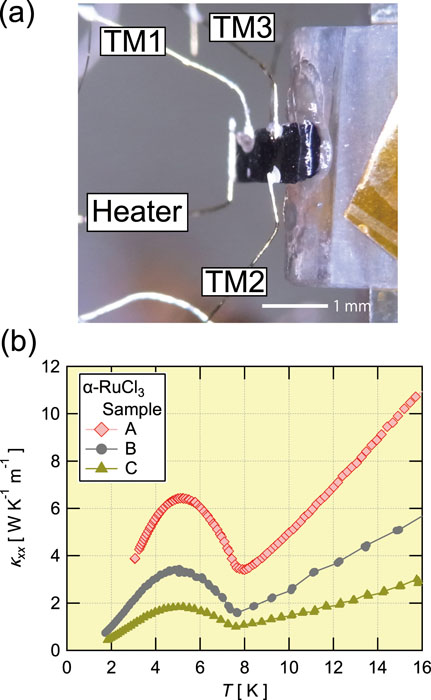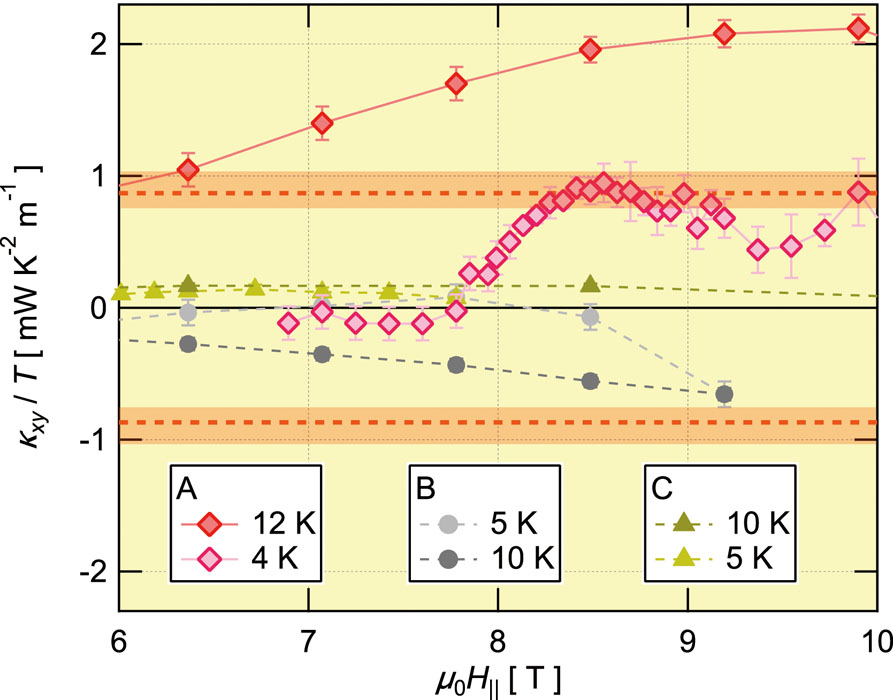Sample Dependence of the Half-Integer Quantized thermal Hall Effect in a Kitaev Candidate α-RuCl3
Yamashita and Uwatoko Groups
Non-trivial topology in a condensed-matter state realizes a quantization of a physical quantity. One of the most fundamental examples is the quantized Hall conductivity in a quantum Hall system, where the quantized Hall conductivity is given by the Chern number determined by the topology of the system.
A new intriguing case of this topological quantization is now found in a magnetic insulator, a Kitaev magnet. In the Kitaev model, localized spin-1/2 moments on a two-dimensional (2D) honeycomb structure are coupled each other by bond-dependent Ising interactions. The frustration effect of this Kitaev Hamiltonian prevents the spins from ordering even at the zero temperature, realizing a quantum spin liquid state. Remarkably, this ground state of the Kitaev Hamiltonian is exactly solvable. The ground state has been shown to be characterized by the two kinds of elementary excitations; itinerant Majorana fermions and localized Z2 fluxes. In a magnetic field, this itinerant Majorana fermions have topologically non-trivial gapped bands with the Chern number C = ±1, giving rise to a quantized chiral edge current protected by the field-induced gap. In contrast to a quantized chiral edge current of electrons in a quantum Hall system, this chiral edge current is carried by the charge neutral Majorana fermions. Therefore, this quantized chiral edge current has been predicted to appear in the 2D thermal Hall conductivity as κ
In this work [1], we reveal that it is necessary to protect the chiral edge current from severe scattering effects on phonons to stabilize the quantized thermal current. We investigate the sample dependence of the longitudinal (κxx) and transverse (κxy) thermal conductivity of three single crystals of α-RuCl3 – a promising candidate realizing the Kitaev spin liquid [2]. We find the half-integer quantized thermal Hall effect in a sample showing the largest κxx among the three crystals (sample A in Fig. 1). On the other hand, the other samples with smaller κxx show κxy much smaller than the value expected for the quantization (Fig. 2). Given that κxx is mostly given by phonons, the different magnitudes of κxx in different samples reflect the different scattering strengths on phonons; phonons in a sample with smaller κxx are exposed in stronger scattering effects. Therefore, the dependence of κxy on κxx shows that the chiral edge current in the Kitaev magnet is sensitive to scattering effects on phonons.

Fig. 1. (a) A setup picture of the thermal conductivity (κxx) and the thermal Hall (κxy) of α-RuCl3 (sample A). The sample was tilted to the base plate so that the magnetic field oriented to 45 degree to the c axis. (b) The temperature dependence of κxx of different samples (A, B, and C) at zero field.
Further, we find that a sample with a larger κxx shows a larger decrease of the magnetic susceptibility below the Néel temperature, in addition to a larger field-increase effect of κxx, showing that magnetic scattering effects are more strongly suppressed by magnetic fields in a sample with a better quality. These results suggest that suppressing this magnetic scattering effect plays an important role to realize the quantized thermal Hall effect.
References
- [1] M. Yamashita et al., Phys. Rev. B 102, 220404(R) (2020).
- [2] Y. Kasahara et al., Nature 559, 227 (2018).

